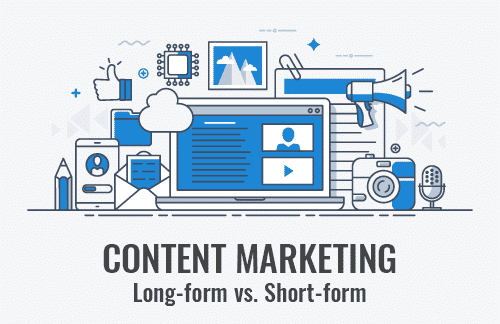How Long Should My Content Be?

Content Marketing continues to grow in importance and it continues to gain larger and larger portions of the marketing resource pie, and for good reason–it works.
In a recent Content Marketing Institute podcast, Content Marketing pros Joe Pulizzi and Robert Rose go as far as to suggest that within 10 years, Content Marketing will lose its identity and just be known as Marketing.1
“A recent Gartner (Research) blog post predicts a future where helpful, engaging, and contextually relevant content will be the hallmark of all marketing – not just the specific discipline we currently know as content marketing.” – Joe Pulizzi, Content Marketing Institute
Most companies by now have employed some type of content marketing program. According to Convince & Convert with Jay Baer, about 70 percent of businesses are currently using some form of content marketing.2 Content can be in many formats and different types of content can be more appropriate than others based on your objectives, audience demographics, the complexity of your product or service and a variety of other factors. One of the most prevalent types of content today, written content, has proven to be successful for companies in building awareness, positioning them as an industry leader and providing numerous SEO benefits.
A question that often torments marketers is “How long should my content be?” Do you invest more resources in developing a lesser quantity of long-form content? Or do you create a higher quantity of short-form pieces of content? This is a great question and unfortunately, there is not a black and white answer.
Long-form vs. Short-form Content
What is Long-form Content?
There are several resources that define long-form content differently. However, most sources agree that content with a word count of 500 to 1,000 words and up can be classified as long-form content. Long-form content can include ebooks, whitepapers and detailed or in-depth website articles or blog posts.
What is Short-form Content?
Similar to long-form content, several resources define short-form content differently. However, most sources agree that content with 250 to 500 words or less falls into the realm of short-form content. Short-form content can include brief and to-the-point blog posts and website articles, social media posts, forum posts and FAQs.
Both long-form and short-form content have their place and each, or an approach that utilizes both can be effective in accomplishing specific marketing objectives. Let’s take a look at the advantages of each.
Advantages of Long-form Content
- Ability to cover complex topics thoroughly.
- Greater opportunity to leverage through SEO.
- Position company as subject-matter expert.
- Opportunity to gate content to drive subscriptions and conversions.
- Generally delivers a greater level of social shares.
Advantages of Short-form Content
- Easier for readers to consume.
- Less time and resources needed to develop.
- Tailored to web users that prefer to quickly scan information.
As you can see, long-form and short-form content both offer unique advantages that may be appropriate and effective in helping you achieve the marketing objectives you are looking to accomplish. If your objective is to build awareness, short-form content can be very effective. If your objective is to drive website traffic and conversions, you may want to consider long-form content.
In some cases, the topic of your content may help decide whether you employ long-form or short-form content, or a combination of the two. For example, if part of your communications strategy is to provide detailed information about a complex product or service, you may want to develop an extensive and inclusive ebook or whitepaper about the subject. Part of your content distribution plan may include several short-form articles supporting the long-form content with additional information and linking back to it. There are lots of scenarios that can make sense and be effective depending on your objectives.
Content Should Be However Long It Needs to Be
One basic rule of thumb we generally try to follow is that content should be however long it needs to be. If you need 500 or more words to adequately cover a subject and provide value to your audience that will read that content, then you probably need to create long-form content. If you can adequately cover and convey the message you are trying to get across with less than 500 words then short-form content is certainly appropriate.
Prospects and customers can certainly read between the lines and will quickly be turned away by “fluff” content that doesn’t provide them any value. Long-form or short-form, focus on your audience and make sure you are providing value with the content you produce and share. Whatever the length, content that provides real value will deliver great results for your brand.
Resources:
1 This Week in Content Marketing: In 10 Years, Content Marketing Will Just Be Marketing

